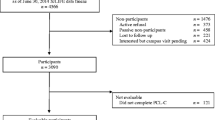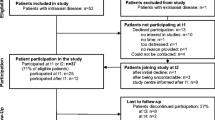Abstract
Purpose
The primary objective of this study was to investigate the incidence of PTSD at 3 months postoperatively in patients who were newly diagnosed with LGGs, and its association with 5-year survival. Moreover, QoL and other psychiatric disorders like depression and anxiety were also evaluated.
Methods
From February 2011 to April 2013, patients who underwent low-grade glioma surgery at our hospital and come back for reexamination at 3-month follow-up were considered for this study. Interviews, HADS-A, HADS-D, and SF-36 scales were used for evaluating PTSD, anxiety, depression, and quality of life. Participants were asked to complete these assessments at 3 months after surgery. Followed-ups on survival status were made for 5 years.
Results
A total of 219 subjects comprising 83 women and 136 men with a mean age of 41.5 years were included in this study. At 3 months after surgery, 35 (16%) patients were diagnosed with PTSD. Younger age (OR = 2.23, [95% CI 1.02–4.84], P = 0.04) and frontal lobe involvement of tumor (OR = 2.57, [95% CI 1.06–6.23], P = 0.04) predicted PTSD. Patients with PTSD had higher anxiety and depression level, and had worse QoL in all eight dimensions of SF-36. Kaplan–Meier analyses demonstrated that diagnosis of PTSD was associated with shorter overall survival in LGG patients (Log-rank = 7.45, P = 0.01). After adjusting for other variables, PTSD remained associated with elevated 5-year overall mortality risk of LGG patients (HR = 2.98 [95% CI 1.10–8.05], P = 0.03).
Conclusions
The results showed that newly diagnosed LGG patients suffering from PTSD at 3 months after surgery had lower rates of 5-year survival. In clinical practice, psychological evaluation is suggested for LGG patients and proper psychotherapy should be considered for those with PTSD.

Similar content being viewed by others
References
Ostrom QT, Gittleman H, Fulop J, Liu M, Blanda R, Kromer C, Wolinsky Y, Kruchko C, Barnholtz-Sloan JS (2015) CBTRUS statistical report: primary brain and central nervous system tumors diagnosed in the United States in 2008–2012. Neuro Oncol 17(4):iv1–iv62
Kumthekar P, Raizer J, Singh S (2015) Low-grade glioma. Cancer Treat Res 163:75–87
Costello A, Shallice T, Gullan R, Beaney R (2004) The early effects of radiotherapy on intellectual and cognitive functioning in patients with frontal brain tumours: the use of a new neuropsychological methodology. J Neuroonc 67(3):351–359
Dijkstra M, van Nieuwenhuizen D, Stalpers LJ, Wumkes M, Waagemans M, Vandertop WP, Heimans JJ, Leenstra S, Dirven CM, Reijneveld JC, Klein M (2009) Late neurocognitive sequelae in patients with WHO grade I meningioma. J Neurol Neursurg Psychiatry 80(8):910–915
Mainio A, Tuunanen S, Hakko H, Niemelä A, Koivukangas J, Räsänen P (2006) Decreased quality of life and depression as predictors for shorter survival amon patients with low-grade gliomas: a follow-up from 1990 to 2003. Eur Arch Psych Clin Neuro 256(8):516–521
Arnold SD, Forman LM, Brigidi BD, Carter KE, Schweitzer HA, Quinn HE, Guill AB, Herndon JE 2nd, Raynor RH (2008) Evaluation and characterization of generalized anxiety and depression in patients with primary brain tumors. Neuro Onc 10(2):171–181
D’Angelo C, Mirijello A, Leggio L, Ferrulli A, Carotenuto V, Icolaro N, Miceli A, D’Angelo V, Gasbarrini G, Addolorato G (2008) State and trait anxiety and depression in patients with primary brain tumors before and after surgery: 1-year longitudinal study. J Neurosurg 108(2):281–286
Rooney AG, Carson A, Grant R (2011) Depression in cerebral glioma patients: a systematic review of observational studies. J Natl Cancer Inst 103(1):61–76
Mainio A, Hakko H, Niemela A, Koivukangas J, Rasanen P (2005) Depression and functional outcome in patients with brain tumors: a population-based 1-year follow-up study. J Neurosurg 103(5):841–847
Bunevicius A, Tamasauskas S, Deltuva V, Tamasauskas A, Radziunas A, Bunevicius R (2014) Predictors of health-related quality of life in neurosurgical brain tumor patients: focus on patient-centered perspective. Acta Neurochir 156(2):367–374
Goebel S, Mehdorn HM (2013) Development of anxiety and depression in patients with benign intracranial meningiomas: a prospective long-term study. Support Care Cancer 21(5):1365–1372
Bunevicius A, Deltuva VP, Tamasauskas A (2017) Association of pre-operative depressive and anxiety symptoms with five-year survival of glioma and meningioma patients: a prospective cohort study. Oncotarget 8(34):57543–57551
Mainio A, Hakko H, Timonen M, Niemela A, Koivukangas J, Rasanen P (2005) Depression in relation to survival among neurosurgical patients with a primary brain tumor: a 5-year follow-up study. Neurosurgery 56(6):1234–1241
Litofsky NS, Farace E, Anderson F Jr, Meyers CA, Huang W, Laws ER Jr (2004) Depression in patients with high-grade glioma: results of the glioma outcomes project. Neurosurgery 54(2):358–366
American Psychiatric Association (1994) Diagnostic and statistical manual of mental disorders, 4th edn. American Psychiatric Association Press, Washington
Robins HI, Johnson L, LoConte N, Brandt K (2017) Cancer-related cognitive impairment and its relation to PTSD. Breast 34:134
Cavalcanti-Ribeiro P, Andrade-Nascimento M, Morais-de-Jesus M, de Medeiros GM, Daltro-Oliveira R, Conceição JO, Rocha MF, Miranda-Scippa Â, Koenen KC, Quarantini LC (2012) Post-traumatic stress disorder as a comorbidity: impact on disease outcomes. Expert Rev Neurother 12(8):1023–1237
Goebel S, von Harscher M, Mehdorn HM (2011) Comorbid mental disorders and psychosocial distress in patients with brain tumours and their spouses in the early treatment phase. Support Care Cancer 19(11):1797–1805
Bruce M, Gumley D, Isham L, Fearon P, Phipps K (2011) Post-traumatic stress symptoms in childhood brain tumour survivors and their parents. Child Care Health Dev 37(2):244–251
Kangas M, Williams JR, Smee RI (2012) The Association between post-traumatic stress and health-related quality of life in adults treated for a benign meningioma. Appl Res Qual Life 7:163–182
Kangas M, Tate RL, Williams JR, Smee RI (2012) The effects of radiotherapy on psychosocial and cognitive functioning in adults with a primary brain tumor: a prospective evaluation. Neuro Oncol 14(12):1485–1502
Creamer M, Bell R, Failla S (2003) Psychometric properties of the impact of event scale-revised. Behav Res Ther 41(12):1489–1496
Zigmond AS, Snaith RP (1983) The hospital anxiety and depression scale. Acta Psychiatr Scand 67:361–370
Bunevicius A, Deltuva V, Tamasauskas S, Tamasauskas A, Bunevicius R (2013) Screening for psychological distress in neurosurgical brain tumor patients using the Patient Health Questionnaire-2. Psychooncology 22(8):1895–1900
Rooney AG, McNamara S, Mackinnon M, Fraser M, Rampling R, Carson A, Grant R (2013) Screening for major depressive disorder validation of 3 self-report instruments. Neuro Oncol 15(1):122–129
Pranckeviciene A, Tamasauskas S, Deltuva VP, Bunevicius R, Tamasauskas A, Bunevicius A (2016) Suicidal ideation in patients undergoing brain tumor surgery: prevalence and risk factors. Support Care Cancer 24(7):2963–2970
Ware JJ, Sherbourne C (1992) The MOS 36-item short-form health survey (SF-36). I conceptual framework item selection. Med Care 30(6):473–483
Forst DA, Nahed BV, Loeffler JS, Batchelor TT (2014) Low-grade gliomas. Oncologist 19(4):403–413
Hendrix P, Hans E, Griessenauer CJ, Simgen A, Oertel J, Karbach J (2017) Neurocognitive status in patients with newly-diagnosed brain tumors in good neurological condition: The impact of tumor type, volume, and location. Clin Neurol Neurosurg 156:55–62
Schiff D (2015) Low-grade gliomas. Continuum (Minneap Minn) 21:345–354
Moschopoulou E, Hutchison I, Bhui K, Korszun A (2018) Post-traumatic stress in head and neck cancer survivors and their partners. Support Care Cancer 26(9):3003–3011
Nipp RD, El-Jawahri A, D’Arpino SM, Chan A, Fuh CX, Johnson PC, Lage DE, Wong RL, Pirl WF, Traeger L, Cashavelly BJ, Jackson VA, Ryan DP, Hochberg EP, Temel JS, Greer JA (2018) Symptoms of posttraumatic stress disorder among hospitalized patients with cancer. Cancer 124(16):3445–3453
Pranjic N, Bajraktarevic A, Ramic E (2016) Distress and PTSD in patients with cancer: cohort study case. Mater Sociomed 28(1):12–16
Hakamata Y, Matsuoka Y, Inagaki M, Nagamine M, Hara E, Imoto S, Murakami K, Kim Y, Uchitomi Y (2007) Structure of orbitofrontal cortex and its longitudinal course in cancer-related post-traumatic stress disorder. Neurosci Res 59(4):383–389
Mainio A, Hakko H, Niemelä A, Tuurinkoski T, Koivukangas J, Räsänen P (2003) The effect of brain tumour laterality on anxiety levels among neurosurgical patients. J Neurol Neurosurg Psychiatry 74(9):1278–1282
Pagotto LF, Mendlowicz MV, Coutinho ES, Figueira I, Luz MP, Araujo AX, Berger W (2015) The impact of posttraumatic symptoms and comorbid mental disorders on the health-related quality of life in treatment-seeking PTSD patients. Compr Psychiatry 58:68–73
Bunevicius A (2018) Personality traits, patient-centered health status and prognosis of brain tumor patients. J Neurooncol 137(3):593–600
Gathinji M, McGirt MJ, Attenello FJ, Chaichana KL, Than K, Olivi A, Weingart JD, Brem H, Quinones-Hinojosa A (2009) Association of preoperative depression and survival after resection of malignant brain astrocytoma. Surg Neurol 71(3):299–303
Author information
Authors and Affiliations
Corresponding author
Ethics declarations
Che Jiang and Jiajia Wang declared no conflict of interest. All procedures performed in studies involving human participants were in accordance with the ethical standards of the institutional research committee and with the 1964 Helsinki declaration and its later amendments or comparable ethical standards. Informed consent was obtained from all individual participants included in the study.
Rights and permissions
About this article
Cite this article
Jiang, C., Wang, J. Post-traumatic stress disorders in patients with low-grade glioma and its association with survival. J Neurooncol 142, 385–392 (2019). https://doi.org/10.1007/s11060-019-03112-3
Received:
Accepted:
Published:
Issue Date:
DOI: https://doi.org/10.1007/s11060-019-03112-3




